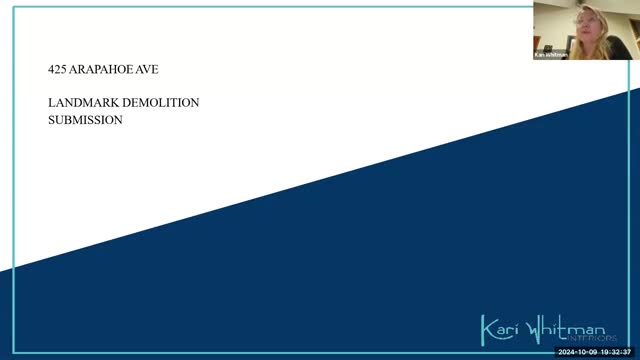Homeowner fights to save trees amid renovation chaos
October 09, 2024 | Boulder, Boulder County, Colorado
This article was created by AI summarizing key points discussed. AI makes mistakes, so for full details and context, please refer to the video of the full meeting. Please report any errors so we can fix them. Report an error »

In a recent meeting, a passionate plea was made regarding the preservation of a property known for its extensive greenery and trees. The property, purchased by a concerned homeowner, was initially acquired to save the lush backyard, which had been meticulously maintained by previous owners who were arborists. The new owner expressed deep concern over potential demolition by builders who might not prioritize the preservation of the natural landscape.
During the discussion, it was revealed that the property is in dire condition, with significant structural and plumbing issues. The homeowner highlighted the need for extensive renovations, including the replacement of outdated plumbing lines, which are a mix of clay, metal, and PVC. The lack of insulation and low ceilings further complicate the situation, raising concerns about the financial viability of restoring the existing structure.
A particular focus was placed on a large spruce tree in the front yard, which had become infested with beetles and posed a risk to the house. Despite efforts to save it, experts recommended its removal to prevent further spread of the infestation. The homeowner plans to replant trees and maintain the property's natural charm, emphasizing a desire to build a quaint, cottage-style home that aligns with the neighborhood's historical aesthetics.
The homeowner is now seeking a demolition permit to proceed with the necessary renovations, expressing hope that the new construction will respect the character of the area while preserving the existing greenery. The commitment to maintaining the outdoor space and the integrity of the neighborhood was a central theme of the discussion, reflecting a broader concern for environmental preservation amidst urban development.
During the discussion, it was revealed that the property is in dire condition, with significant structural and plumbing issues. The homeowner highlighted the need for extensive renovations, including the replacement of outdated plumbing lines, which are a mix of clay, metal, and PVC. The lack of insulation and low ceilings further complicate the situation, raising concerns about the financial viability of restoring the existing structure.
A particular focus was placed on a large spruce tree in the front yard, which had become infested with beetles and posed a risk to the house. Despite efforts to save it, experts recommended its removal to prevent further spread of the infestation. The homeowner plans to replant trees and maintain the property's natural charm, emphasizing a desire to build a quaint, cottage-style home that aligns with the neighborhood's historical aesthetics.
The homeowner is now seeking a demolition permit to proceed with the necessary renovations, expressing hope that the new construction will respect the character of the area while preserving the existing greenery. The commitment to maintaining the outdoor space and the integrity of the neighborhood was a central theme of the discussion, reflecting a broader concern for environmental preservation amidst urban development.
View full meeting
This article is based on a recent meeting—watch the full video and explore the complete transcript for deeper insights into the discussion.
View full meeting
